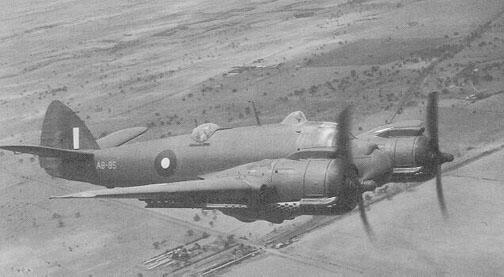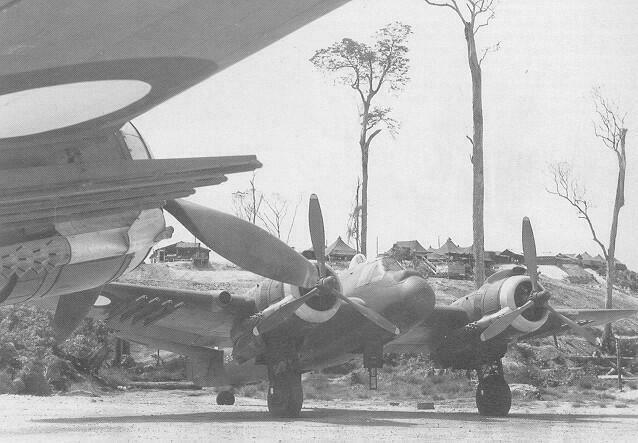BRITISH AVIATION RESOURCE CENTER > FIGHTERS > BEAUFORT > PREVIOUS PAGE
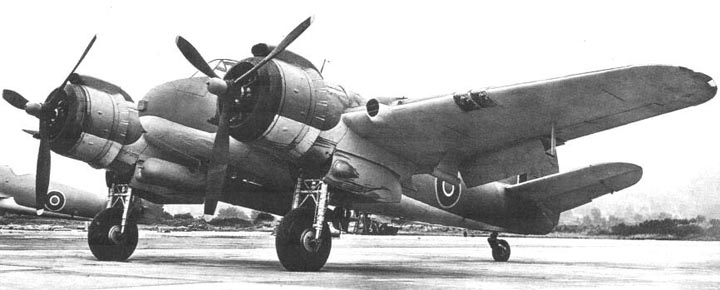
|
Type: Torpedo Strike Fighter, Nightfighter, target tug. Origin: Bristol Models: Beaufighter I to TF.X Crew: Two First Flight: Type 156 Prototype: July 17, 1939 Prototype Mk. I: May 1940 Mk. 21, Australia: May 26, 1944 Service Delivery: July 27, 1940 Final New Delivery, UK: September 1945 Final New Delivery, Australia: October 1945 Number Produced: 5,564 in England, 365 in Australia. POWERPLANT(S): Beaufighter Mk. I: Model: Bristol Hercules III Type: 14-Cylinder sleeve valve radial Number: Two Horsepower: 1,650 hp Beaufighter Mk. II: Model: Rolls-Royce Merlin XX Type: 12-Cylinder liquid cooled Vee Number: Two Horsepower: 1,250 hp Beaufighter Mk. X: Model: Bristol Hercules XVII Type: 14-Cylinder sleeve valve radial Number: Two Horsepower: 1,770 hp DIMENSIONS: Wing span (Typical): 57 ft. 10 in. (17.63m) Length: Typical: 41 ft. 8 in. (12.6m) Mk. II: 42 ft. 9 in. Height: 15 ft. 10 in. (4.84m) Wing Surface Area: N/A |
WEIGHTS: Empty: Typical: 15,600 lb. (7100 kg) Mk. I, II: 13,800 lb. Mk. VI, XI: 14,900 lb. Loaded: Typical: 21,000 lb. (9525 kg) Mk. X: 25,400 lb. (11,530 kg) PERFORMANCE: Maximum Speed: Typical: 312 mph (502 km/h) Fighter Marks: 330 mph (528 km/h) Initial Climb: 1,850 ft/min (564 m/min) Service Ceiling: 26,500 ft. (8077m) Range: 1,540 miles (2478 km) ARMAMENT: Four 20mm Hispano cannon fixed under nose. Ammunition: 60 rounds per gun.* *Initially hand loaded drums, later belt fed. One .303 in. Vickers K aimed by observer. Fighter Marks, in addition to above: Four .303 in. Brownings fixed in starboard wing. Two .303 in. Brownings fixed in port wing. |

|
Design and development - Source: Wikipedia The idea of a fighter development of the Beaufort was suggested to the Air Ministry by Bristol. The suggestion coincided with the delays in the development and production of the Westland Whirlwind cannon-armed twin-engined fighter. By converting an existing design the "Beaufort Cannon Fighter" could be expected to be developed and produced far quicker than starting a completely fresh design from scratch. Accordingly the Air Ministry produced specification F.11/37 written around Bristols suggestion for an "interim" aircraft pending proper introduction of the Whirlwind. Bristol started building a prototype by taking a part-built Beaufort out of the production line. This prototype first flew on 17 July 1939, a little more than eight months after the design had started and possible due to the use of as many of the Beaufort's design and parts. A production contract for 300 machines had already been placed two weeks before the prototype flew, as F.17/39. In general, the differences between the Beaufort and Beaufighter were minor. The wings, control surfaces, retractable landing gear and aft section of the fuselage, were identical to those of the Beaufort, while the wing center section was similar apart from certain fittings. The bomb-bay was dispensed with, and a forward-firing armament of four Hispano 20 mm cannons was mounted in the lower fuselage area. (These initially were drum-fed cannon, necessitating the radar operator having to manually change the ammunition drums—an arduous and unpopular task, especially at night and in the midst of a chase with a bomber target.) The areas for the rear gunner and bomb-aimer were removed, leaving only the pilot in a smoother, fighter-type cockpit. The navigator/radar operator sat far to the rear in a small bubble where the Beaufort's dorsal turret had been located. The Bristol Taurus engines of the Beaufort would not be sufficient for a fighter and were replaced by the more powerful Bristol Hercules. This extra power presented problems with vibration. In the end they were mounted on longer, more flexible struts, which stuck out from the front of the wings. This had the side effect of moving the centre of gravity (CoG) forward, generally a bad thing for an aircraft design. It was then moved back into place by cutting back the nose area, which was no longer needed for the bomb-aimer in the fighter role. This put most of the fuselage behind the wing and moved the CoG back to where it should be, leading to the Beaufighter's famous stubby appearance. Production of the Beaufort in Australia, and the highly successful use of British-made Beaufighters by the Royal Australian Air Force, led to Beaufighters being built by the Australian Department of Aircraft Production (DAP), from 1944 onwards. Australian-built examples are generally known as the DAP Beaufighter. The DAP's variant was an attack/torpedo bomber, known as the Beaufighter Mark 21: design changes included Hercules CVII engines, a dihedral tailplane and enhanced armament. By the time British production lines shut down in September 1945, 5,564 Beaufighters had been built in England, by a number of manufacturers as well as Bristol: Fairey Aviation, (498) MAP (3336) and Rootes Securities Ltd (260). When Australian production ceased in 1946, 365 Mk 21s had been built.
Operational service - Source: Wikipedia The Beaufighter's main claim to fame would be that it was coming off the production lines at almost exactly the same time as the first British airborne radar sets. With the four 20 mm cannons mounted in the lower fuselage, the nose could accommodate the radar antennas, and the general roominess of the fuselage enabled the AI equipment to be fitted easily. Even loaded down to an even heavier 20,000 lb (9 t), the plane was still fast enough to catch the even slower German bombers. By early 1941, it was an effective counter to Luftwaffe night raids. The various early models of the Beaufighter soon commenced service overseas, where its rugged build and reliability soon made the aircraft popular with its crews. A night-fighter Mk VIF was supplied to squadrons in March 1942, equipped with AI Mark VIII radar. As the faster de Havilland Mosquito took over in the night fighter role in mid to late 1942, the heavier Beaufighters made sterling contributions in other areas, such as anti-shipping, ground attack and long-range interdiction in every major theatre of operations. In the Mediterranean, the USAAF's 414th, 415th, 416th and 417th Night Fighter Squadrons received 100 Beaufighters in the summer of 1943, achieving their first victory in July 1943. Through the summer the squadrons conducted both daytime convoy escort and ground-attack operations, but primarily flew defensive interception missions at night. Although the Northrop P-61 Black Widow fighter began to arrive in December 1944, USAAF Beaufighters continued to fly night operations in Italy and France until late in the war. By the autumn of 1943 the Mosquito was available in enough numbers to replace the Beaufighter as the primary night fighter of the RAF. By the end of the war some 70 pilots serving with RAF units had become aces while flying Beaufighters.
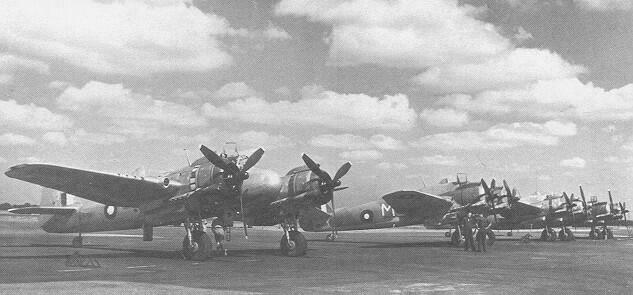
1941 saw the development of the Beaufighter Mk IC long-range heavy fighter. This new variant entered service in May 1941 with a detachment from No. 252 Squadron operating from Malta. The aircraft proved so effective in the Mediterranean against shipping, aircraft and ground targets that Coastal Command became the major user of the Beaufighter, replacing the obsolete Beaufort and Blenheim. Coastal Command began to take delivery of the up-rated Mk VIC in mid 1942. By the end of 1942, Mk VICs were being equipped with torpedo-carrying gear, enabling them to carry the British 18-inch or the US 22.5-inch torpedo externally. The first successful torpedo attacks by Beaufighters came in April 1943, with No. 254 Squadron sinking two merchant ships off Norway. The Hercules Mk XVII, developing 1,735 hp at 500 feet was installed in the Mk VIC airframe to produce the TF (Torpedo Fighter) Mk X - commonly known as the "Torbeau." The Mk X became the main production mark of the Beaufighter. The strike variant of the Torbeau was designated the "Mk XIC." Beaufighter TF Xs would make precision shipping attacks at wave-top height with torpedoes or rockets. Early models of the Mk Xs carried ASV (air-to-surface vessel) radar, but this was replaced in late 1943 by AI Mark VIII radar, housed in a "thimble-nose" radome, enabling all-weather and nighttime attacks. The North Coates Strike Wing (Coastal Command) developed attack tactics combining large formations of Beaufighters on anti-flak suppression with cannon and rockets while the Torbeaus attacked on low level. These tactics were put into practice in mid 1943 and in a 10 month period 27,000 tonnes of shipping were sunk. Tactics were further adapted when shipping was moved from port during night hours. The Coastal Command RAF North Coates Strike Wing operated as the largest anti-shipping force of the Second World War, and accounted for over 150,000 tons of shipping and 117 vessels for a loss of 120 Beaufighters and 241 aircrew killed or missing. This was half the total tonnage sunk by all strike wings between 1942-45.
Pacific War - Source: Wikipedia
South East Asia - Source: Wikipedia
South West Pacific - Source: Wikipedia
Postwar - Source: Wikipedia
The Beaufighter was also used by the Portuguese Air Force, as well as the air forces of Turkey and the Dominican Republic. It was used briefly by the Israeli Air Force. |
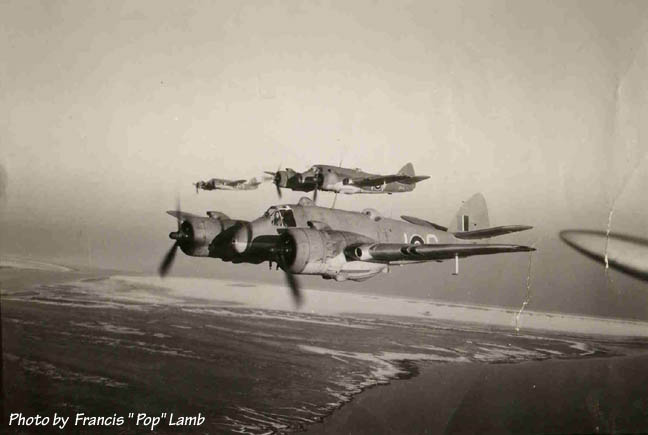
|
Beaufighter Mk IF Two-seat night fighter variant.
Beaufighter Mk IC
Beaufighter Mk II
Beaufighter Mk IIF
Beaufighter Mk III/IV
Beaufighter Mk V
Beaufighter Mk VI |
Beaufighter Mk VIC Torpedo-carrying variant dubbed the "Torbeau".
Beaufighter Mk VIF
Beaufighter Mk VI (ITF)
Beaufighter TF Mk X
Beaufighter Mk XIC
Beaufighter Mk 21
Beaufighter TT Mk 10
|
Gunston, Bill - The Encyclodepia of the Worlds Combat aircraft, 1976, Chartwell Books, Inc., New York
Green, William - War Planes Of The Second World War - Fighters - Vol. 2, 1961, Hanover House, New York
Wikipedia
BRITISH AVIATION RESOURCE CENTER > FIGHTERS > BEAUFORT > PREVIOUS PAGE

